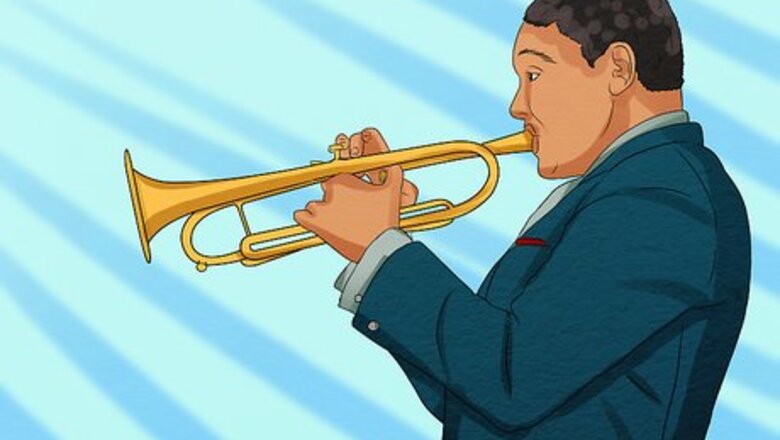
views
X
Research source
Sometimes restrained and intimate, other times boisterous and exciting, still other times sultry and seductive, jazz music has a little something for everyone. Beyond that, jazz has contributed heavily to contemporary music, and by gaining a better appreciation of jazz, you may deepen your appreciation of your favorite hits as well.[2]
X
Research source
Knowing What to Look for in Jazz

Pick out the original melody. The melody is the main theme of a song. In jazz, it's common for you to hear the same song twice and notice many differences between performers, performances, and even recordings. This is because jazz musicians have a great deal of freedom in how they play the base melody serving as the foundation for its sound. Learning to pick out the main melody among the complex variations of individual instrumentalists is part of the fun of jazz! You may notice that some performers have certain features or a distinct sound. Picking out and noticing these features can be a fun way for you to engage the music. If you hear a melody you particularly enjoy, you may want to explore variations of it. To do this, you might search for performances of the same song by different jazz artists or ensembles online. Listening to a song you're already somewhat familiar with may help you pick out the melody more easily. Some famous jazz hits you might want to give a listen to include "Take Five," "Sing, Sing Sing," "So What," and " 'Round Midnight."
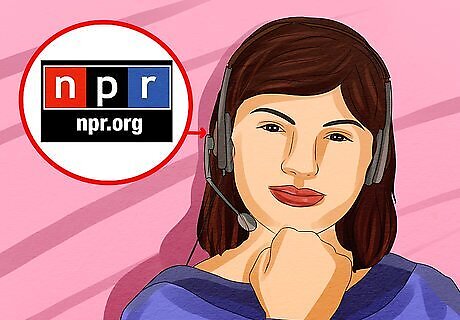
Develop a feel for the harmony. There are many layers to jazz music. The melody should be the most distinct, topmost layer, but behind that you should hear a harmonious structure of chords. Generally, there will be three different chords used, with each of these being played in various ways to give the harmony of the song a broad range of variety. It's very common for artist to break up harmonic chords to create a sustained, pleasing sound while the melody is played. You may want to keep an ear out for broken chords, rolled chords, and other variations in the harmony while listening to jazz. Many public radio services, like your local classical/jazz station or NPR, have segments devoted to jazz music. You may learn more about harmony listening to these segments and the accompanying commentary of the DJs.

Catch the rhythm. The complex and regularly changing rhythms of jazz are a key feature to the genre. The main beat of a song will often be elongated or shortened to add punch and flourish to the musical phrases in it. You can easily notice where artists take liberties with the beat by following along with the main beat yourself. While listening, it may help you follow the beat if you tap your foot or your hand steadily in time with the music. This will be the dominant rhythm of the song. When you notice players hold out or cut short beats, you've discovered a change to the rhythm. These off-beat rhythms generally sync up with the main beat later on. You may want to tap along quietly, especially if you are attending a live jazz performance. Following the beat too loudly by clapping/tapping your hands/feet could disrupt the musicians. Swing music, having a pronounced rhythmic quality, may make feeling the rhythm easier for you. Some popular swing tunes you might be interested hearing include "Caravan," "Take the 'A' Train," and "Sweet Georgia Brown."
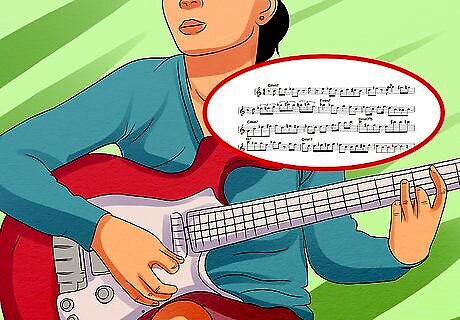
Assess the forms of improvisation being used. Improvisation may be the feature of jazz most familiar to you. However, you may not know that there are different kinds of improv that jazz musicians use when playing. These are broken up into three main categories that you may want to keep in mind when listening: Paraphrase improv. Paraphrase improv uses the melody like a springboard. Oftentimes, an artist will feature the melody strongly throughout the piece, waiting for specific places or themes before exploding into a variation. Motivic improv. The name of this kind of improv comes from the word "motif." It uses repeated sections of the song at higher and lower intervals to change the atmosphere and quality of the motif being repeated. Formulaic improv. This kind of improv requires the most technical knowledge on the part of the performer. During formulaic improv, a musician will insert highly complex combinations of notes, often referred to as "licks," to spice up a solo.
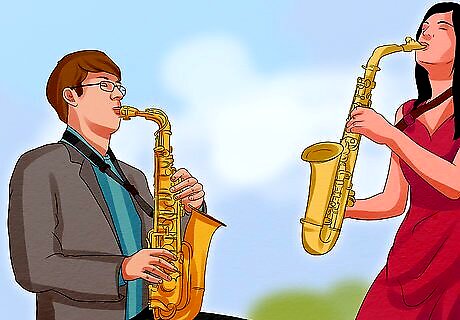
Recognize the unity of the ensemble. Since improvisation is such an important part of jazz music, the players in an ensemble must be well coordinated for there to be cohesion throughout a performance. In many cases, this takes the form of signals, gestures, or other kinds of cues between players, like a certain riff played on an instrument or a particular note in the melody that's leaned on heavily. Looking for the signals between performers, or even noting the level of unity and balance among them, can add another level to your jazz appreciation. You may find that, even if you don't like the tune, the interaction between players still makes the music enjoyable.
Enjoying Jazz
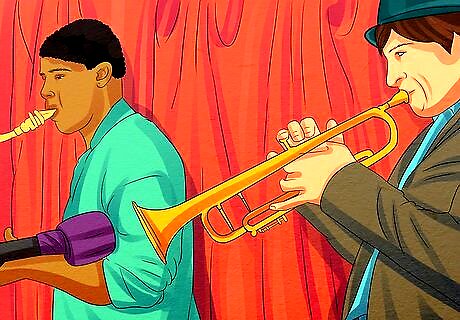
Attend a jazz venue. There may be a local jazz club or bar near you where you can listen to jazz. However, if this kind of environment isn't your scene, many universities and music institutes/conservatories put on jazz events throughout the year that you can attend. One benefit to seeing jazz live is its engagement of your senses. Not only can you hear the music and see the performers in action, but in many cases you will be able to feel the music as its vibrations hit your skin. Observe good etiquette while you're at a jazz performance. This is especially important at a jazz club or bar. Most performers will expect you to be respectful during the performance; this means you should keep the volume of your conversations to a minimum. The spontaneous nature of jazz makes live events the perfect place for you to get into the spirit of the genre. Recordings, in many cases, fail to convey the atmosphere of a performance.
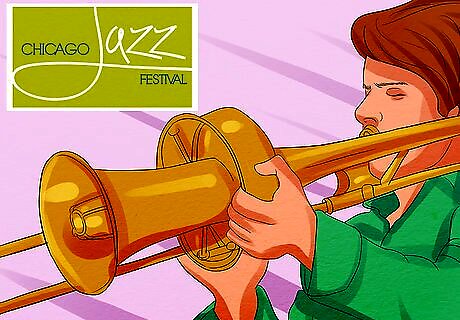
See a jazz festival. Many communities put on local events and festivals celebrating the jazz, its history, and its culture. This is an excellent opportunity for you to mingle with and learn from longtime jazz fans and musicians. At many of these events, influential jazz artists as well as up-and-comers will play music, giving you a chance to hear contemporary and classic jazz. Depending on the region in which you live, the kind of festivals available will vary. Some major jazz festivals you might consider visiting include the Chicago Jazz Music Festival (late August/early September), Saratoga Jazz Festival (late June), Portland Jazz Festival (mid February), Fillmore Street Jazz Festival (early July), and Jacksonville Jazz Festival (late May).

Be in the moment. While listening to the jazz, it's easy to get caught up in technical details or you can be distracted by your search for specific features in a song or ensemble. Ultimately, jazz is based on the emotions of the performers. The sound they craft during a performance is intended to capture that feeling, whatever it may be. Try to feel with the performers as they play. Although the atmosphere of a venue can contribute a great deal to the atmosphere, it can also be distracting. You may want to close your eyes during part of the performance, and see what feelings, colors, shapes, or thoughts are evoked by the music.

Get into the swing of it. The "swing" rhythm used in jazz songs infuses the music with a sense of forward momentum, bounciness, lightness, and urgency. This excitable ambiance looks for a similar response the listener, creating a kind of conversation between performers and audience. This is intentional, as swing was derived from call-and-response musical styles of that time. Jazz was originally used as dance music in the early 1900s for youth rebelling against musical and social conventions. If you're at an appropriate venue, you may find that you connect better with jazz when you get out of your seat and start dancing along.
Understanding the Evolution of Jazz
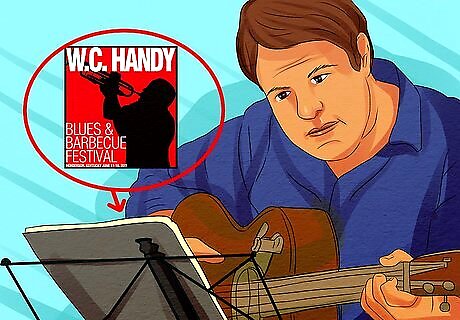
Brush up on the blues. Because jazz and the blues essentially grew up alongside each other in the early 1900s, you'll find many similarities between the two genres of music. In particular, you'll notice that both jazz and the blues make use of blue notes, which are notes played a little lower than the major scale of a piece. This gives the music its iconic, mournful, "bluesy" sound. In listening to blues and other music originating from the same period as jazz, you'll gain a finer understanding for the atmosphere of that era. This could help you connect more deeply with the music on an emotional or technical level. The blues have been played in some form or another since the late 1800s, so there are many artists in this genre you might listen to. However, three blues musicians highly influential to the jazz scene include W.C. Handy, Huddie “Lead Belly” Ledbetter, and Bessie Smith.

Listen to ragtime. Ragtime introduced the jazz scene to syncopation, which is the practice of strengthening weak beats and weakening strong beats. This style is featured extensively in jazz. You should note the offbeat quality syncopation gives jazz music. This creates variety and a sense of drive in the music that makes it more exciting. You can get a better feel for syncopation with a foot tapping exercise. Tap your foot up and down steadily. When you bring your foot down, say "Oom" and when you raise your foot say "pah." So as you tap, you should say "Oom-pah, oom-pah." Then, while continuing tapping your foot, only say the "pah." This "pah" represents the syncopated beat. Jazz artists will include a mix of syncopated (off-beat) and non-syncopated (on-beat) rhythms. This creates additional complexity and emphasis in the song. Identifying off- and on-beat rhythms may add a new dimension to your appreciation of jazz.

Get a taste of New Orleans jazz. The New Orleans music scene greatly encouraged the use of brass instruments and syncopation in jazz while contributing to ensemble structure. This structure generally relied on a brass instrumentalist, frequently called the "frontline," and a two person rhythm section. Popular frontline instruments included the trumpet, cornet, trombone, and clarinet. Rhythm section instruments often included the piano, drums, string bass, and banjo. Thanks to the invention of the phonograph, many classic songs that came out of the New Orleans jazz age could be preserved. Listen along with Joe “King” Oliver, Jelly Roll Morton, and The Original Dixieland Jass Band to familiarize yourself with New Orleans jazz.
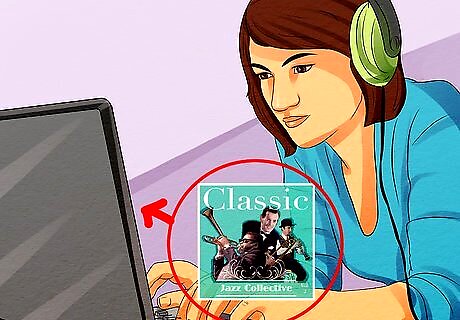
Continue learning about jazz. Jazz has a long and colorful history that includes many styles and sub-genres. Classic jazz, swing, bebop, cool jazz, bossa nova, jazz fusion, acid jazz, and other jazz sub-genres ensure that you'll have plenty to listen to in your journey to gain a better appreciation of jazz. To gain a more formal understanding of jazz and jazz history, you may want to take a class on the subject. These can frequently be found at your nearest local university, community college, community center, or school of music. You may find that a trip to a historic jazz site, like a nightclub or historic jazz composer's home, gives you a fuller understanding of jazz. Many of these sites have information in the form of pamphlets that you can use to buff up on jazz.




















Comments
0 comment